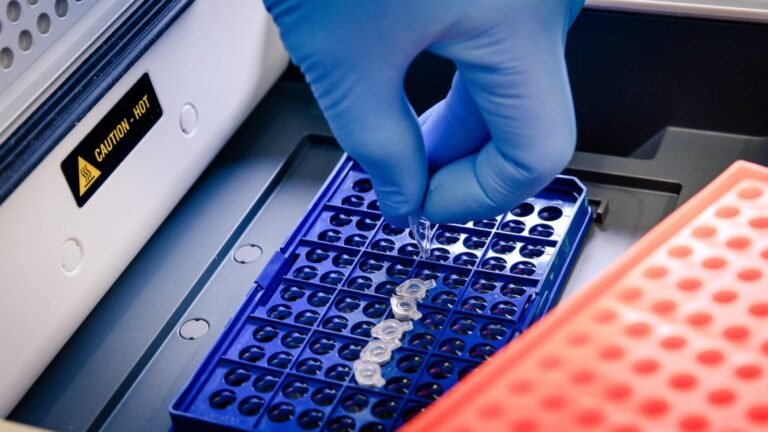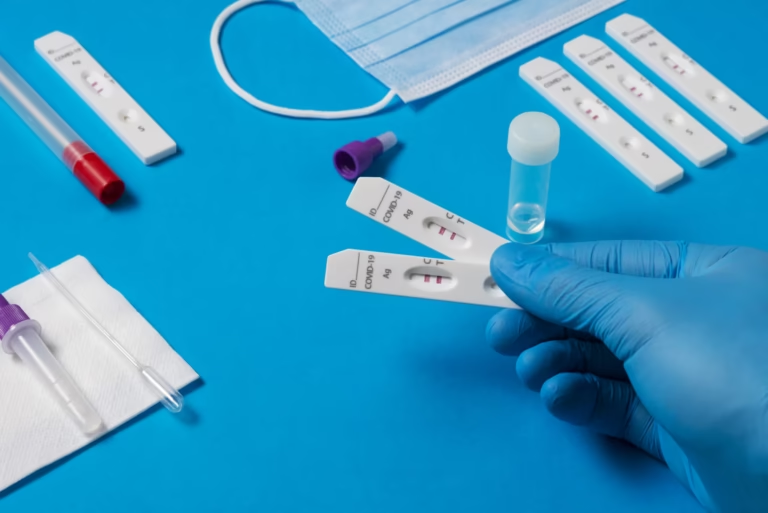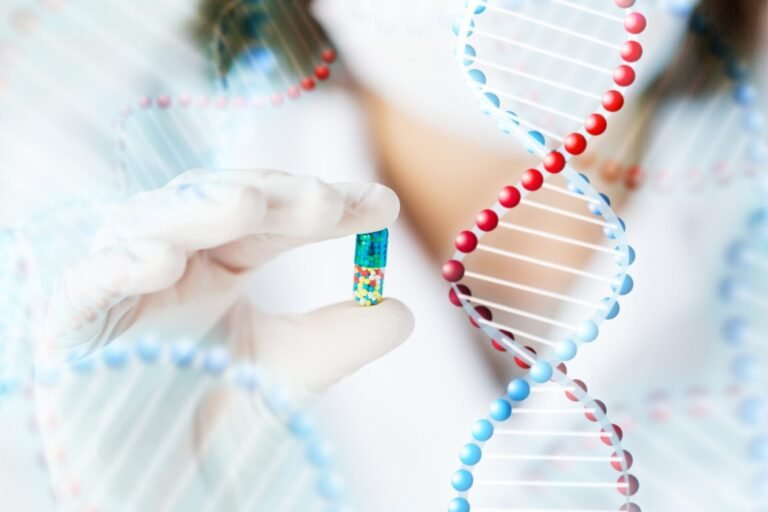Communicating with Patients about Pharmacogenomics
Communicating with patients about pharmacogenomics is essential for improving healthcare outcomes and patient understanding. Pharmacogenomics, also known as PGx, is the study of how an individual’s genes can impact their response to medications. By analyzing a patient’s genetic makeup, healthcare providers can tailor medication treatment plans to optimize efficacy and minimize adverse reactions.

Key Takeaways:
- Communicating about pharmacogenomics plays a crucial role in improving healthcare outcomes.
- Patients need to understand the implications of their pharmacogenomic test results.
- Challenges in communication include health literacy, genetic literacy, and medical jargon.
- Strategies like using plain language, visual aids, and personalized approaches improve patient comprehension.
- Developing educational materials customized to individual patients enhances understanding.
Importance of Doctor-Patient Communication and Communicating with Patients about Pharmacogenomics
Doctor-patient communication is essential for building a strong therapeutic relationship and ensuring patient satisfaction with care. Effective communication between doctors and patients has been shown to improve patient adherence to treatment plans and lead to better health outcomes. When doctors are able to provide clear and concise explanations, actively listen to patients, and understand their concerns and preferences, it fosters a sense of trust and collaboration in the patient-provider relationship.
Within the context of pharmacogenomics, the importance of effective communication becomes even more evident. Patients need to fully understand the implications of their pharmacogenomic test results and how it may impact their medication regimens. By effectively communicating this information, healthcare providers can empower patients to make informed decisions about their treatment plans and actively participate in their own healthcare journey.
Studies have shown that patients who feel heard and understood by their doctors are more likely to adhere to their prescribed medications and treatment plans. Improved patient adherence not only leads to better health outcomes but also reduces the risk of medication errors, adverse drug reactions, and hospital readmissions. Additionally, when patients are satisfied with their communication with healthcare providers, they are more likely to have higher levels of trust, confidence, and overall satisfaction with their healthcare experience.
In summary, effective doctor-patient communication plays a crucial role in patient satisfaction and improving health outcomes. By fostering open and collaborative communication, healthcare providers can enhance patient understanding, promote medication adherence, and ultimately contribute to better overall patient care.
Challenges in Communicating Pharmacogenomics Information
Effective communication of pharmacogenomics information to patients can present several challenges. Healthcare providers need to navigate these obstacles to ensure patients understand complex genetic concepts and test results. The challenges include:
- Health Literacy: Patients with low health literacy may struggle to comprehend the technical information related to pharmacogenomics. Limited knowledge about genetics and medical terminology can hinder their understanding of test results and their implications.
- Genetic Literacy: Similarly, patients with limited genetic literacy may have difficulty grasping the underlying genetic principles and how they relate to their healthcare. These patients may need additional support and explanations to fully comprehend pharmacogenomics information.
- Medical Jargon: The use of medical jargon and technical terminology can further complicate communication with patients. Complex terms and specialized language may alienate patients and impede their ability to understand the information being conveyed.
To address these challenges, healthcare providers must be aware of the varying health and genetic literacy levels among patients. They should use plain language and avoid jargon to explain pharmacogenomics information clearly and effectively. By employing simplified explanations and providing educational resources, healthcare providers can enhance patients’ understanding and empower them to make informed decisions about their healthcare.
Strategies for Effective Communication
To effectively communicate with patients about pharmacogenomics, healthcare providers can employ several strategies. By implementing these strategies, healthcare providers can enhance patient understanding and facilitate informed decision-making. The following strategies are particularly effective:
1. Use Plain Language
Using plain language is crucial in ensuring that patients can easily comprehend complex pharmacogenomic information. Avoiding medical jargon and technical terminology allows patients to understand the information better. By using simple and clear language, healthcare providers can bridge the gap between scientific concepts and patient comprehension.
2. Utilize Visual Aids
Visual aids such as diagrams, charts, and infographics can significantly enhance patient comprehension. These visual representations make complex concepts more accessible and help patients grasp the information more effectively. Visual aids can be used to illustrate how pharmacogenomic test results impact medication regimens, making it easier for patients to understand and remember.
3. Personalize the Communication
Tailoring the communication to the patient’s specific medication regimen and health condition can greatly improve their understanding of pharmacogenomics. Healthcare providers can explain how the test results relate to the patient’s unique circumstances, making the information more relevant and relatable. Personalized communication allows patients to see the direct impact on their own healthcare journey.
4. Provide Clear and Concise Information
Offering patients clear and concise information is essential for effective communication about pharmacogenomics. Break down complex concepts into digestible pieces of information to avoid overwhelming patients. Providing key takeaways and actionable steps helps patients retain the information and make informed decisions about their treatment options.
5. Encourage Questions and Shared Decision-Making
Creating a safe and supportive environment where patients feel comfortable asking questions is vital. Encourage patients to actively participate in discussions about pharmacogenomics and their treatment plans. Shared decision-making empowers patients to be partners in their care, leading to better adherence and improved treatment outcomes.
By employing these strategies for effective communication, healthcare providers can enhance patient understanding of pharmacogenomics and facilitate informed decision-making. This personalized approach helps patients navigate the complexities of pharmacogenomics and empowers them to actively engage in their own healthcare.
Developing Patient Educational Materials
Developing patient educational materials is crucial for enhancing patient understanding of pharmacogenomics. These materials play a vital role in improving comprehension and utility, empowering patients to make informed decisions about their healthcare. When it comes to pharmacogenomics, clear and concise educational materials are essential in helping patients comprehend key concepts and the implications of their test results.
Personalization is key to enhancing the relevance and usefulness of patient educational materials. By customizing the information to each patient’s medications or disease conditions, healthcare providers can address their specific needs and concerns. This personalized approach ensures that patients can easily relate the educational materials to their own healthcare journey, enhancing their engagement with the content.
Furthermore, patient educational materials should be designed with customization in mind. By anticipating the common concerns and questions that patients may have about pharmacogenomics, these materials can proactively address the uncertainties that patients may face. Clear explanations, practical examples, and relatable scenarios can greatly enhance patients’ comprehension of pharmacogenomics and its implications for their treatment plans.
Visual aids, such as diagrams, charts, and infographics, are valuable tools in patient education. These visual representations can simplify complex concepts and reinforce understanding. Including visual aids in educational materials not only improves comprehension but also increases engagement and retention of the information.
By investing in the development of comprehensive patient educational materials, healthcare providers can empower their patients with the knowledge they need to make informed decisions about their pharmacogenomic test results. These materials, when designed with comprehension, utility, and customization in mind, can serve as valuable resources in facilitating effective communication and improving overall patient outcomes.
The Role of Healthcare Providers in Communication
Healthcare providers play a vital role in communicating with patients about pharmacogenomics. To effectively engage with patients, providers must possess strong communication skills, including active listening, empathy, and the ability to explain complex information in a clear and concise manner. By utilizing these skills, providers can ensure that patients fully understand the implications of their pharmacogenomic test results and how it may impact their treatment.
In addition to communication skills, healthcare providers should also have a deep understanding of pharmacogenomics. They should be knowledgeable about the science behind pharmacogenomic testing and its application in personalized medicine. This knowledge enables providers to address patients’ questions and concerns, allowing for a more informed discussion about treatment options and medication management.
Patient education and counseling sessions play a crucial role in enhancing communication between healthcare providers and patients. These sessions provide an opportunity for providers to deliver personalized information, tailored to each patient’s unique health condition and medication regimen. By engaging in patient education and counseling, providers can ensure that patients have a comprehensive understanding of their pharmacogenomic test results and the potential impact on their treatment plan.
Effective communication between healthcare providers and patients also fosters a sense of trust and collaboration. It allows patients to actively participate in their treatment decisions and make informed choices based on their pharmacogenomic information. This shared decision-making approach promotes patient autonomy and leads to improved healthcare outcomes.
“Effective communication between healthcare providers and patients facilitates a collaborative approach to care, ensuring that patients are well-informed and actively engaged in their treatment decisions.”
The image above portrays the important role that healthcare providers play in facilitating effective communication with patients. Through their communication skills and expertise in pharmacogenomics, providers can effectively convey complex information and empower patients to make informed decisions about their healthcare.
Benefits of Effective Communication:
- Enhanced patient understanding of pharmacogenomic test results
- Improved patient adherence to treatment plans
- Increased patient satisfaction with care
- Reduced medication errors and adverse drug reactions
- Better management of chronic conditions
To summarize, healthcare providers with strong communication skills and pharmacogenomic knowledge play a critical role in effectively communicating with patients about pharmacogenomics. By conducting patient education and counseling sessions, providers can ensure that patients comprehend their test results and actively participate in their treatment decisions. Through effective communication, healthcare providers empower patients, leading to improved healthcare outcomes and patient satisfaction.
Overcoming Barriers to Communication
Effective communication with patients about pharmacogenomics can be hindered by various barriers that healthcare providers need to address. Low health literacy levels, cultural and language barriers, and patient engagement issues can all pose challenges to effective communication.
One of the main barriers to communication is low health literacy. Many patients may struggle to understand complex medical information, including the concepts and implications of pharmacogenomics. To overcome this barrier, healthcare providers should use plain language and avoid medical jargon when communicating with patients. By using clear and simple language, patients are more likely to comprehend the information and make informed decisions about their pharmacogenomic test results.
Cultural and language barriers can also impede communication. Healthcare providers should recognize and respect cultural differences when discussing pharmacogenomics with patients. Offering language interpretation services can help bridge the language barrier and ensure that patients fully understand the information being conveyed. Additionally, providing culturally sensitive educational materials can enhance comprehension and engagement.
Patient engagement issues can further complicate communication. It is essential to actively involve patients in the communication process, ensuring they have an opportunity to ask questions and express their concerns. By engaging patients and involving them in decision-making regarding their pharmacogenomic test results, healthcare providers can foster a collaborative approach to care.
“Effective communication is not only about conveying information; it is about understanding, empathy, and achieving mutual clarity.”
In order to overcome these barriers to communication, healthcare providers should:
- Use plain language and avoid medical jargon.
- Offer language interpretation services.
- Provide culturally sensitive educational materials.
- Engage patients in the communication process and involve them in decision-making.
By addressing these barriers, healthcare providers can ensure that patients have a clear understanding of their pharmacogenomic test results and enable them to actively participate in their treatment decisions.

The Impact of Effective Communication on Patient Adherence
Effective communication about pharmacogenomics plays a critical role in improving patient adherence to medication regimens. When patients fully understand the rationale behind their personalized treatment plans based on their pharmacogenomic test results, they are more likely to adhere to the prescribed medications. This level of understanding empowers patients to take an active role in their own medication management.
Improved medication adherence has a profound impact on treatment outcomes. By consistently following their medication regimens, patients can achieve better therapeutic effects and avoid potential complications. Adherence to prescribed medications also reduces the risk of adverse drug reactions, ensuring patient safety. When patients are dedicated to their medication management, healthcare providers can more accurately gauge treatment efficacy and make appropriate adjustments if necessary.
Furthermore, effective communication positively influences patient satisfaction with their healthcare experience. When patients are well-informed about the implications of their pharmacogenomic test results and understand the importance of medication adherence, they feel more involved in their own care. This sense of involvement not only enhances patient satisfaction but also promotes a stronger doctor-patient relationship built on trust and collaboration.
To summarize, effective communication about pharmacogenomics significantly impacts patient adherence to medication regimens, leading to better treatment outcomes, reduced adverse drug reactions, and enhanced overall patient satisfaction with their healthcare experience.
Conclusion
In conclusion, effective communication with patients about pharmacogenomics is paramount in enhancing understanding and improving healthcare outcomes. By employing strategies such as using plain language, visual aids, and personalized approaches, healthcare providers can effectively communicate complex pharmacogenomics information and ensure patients fully comprehend it. Moreover, developing patient educational materials tailored to individual patients’ medication regimens and health conditions enhances comprehension and utility.
Overcoming barriers to communication, including low health literacy and cultural differences, is crucial to empower all patients to make informed decisions about their pharmacogenomic test results. By prioritizing effective communication, healthcare providers enable patients to actively participate in their treatment plans and improve medication adherence.
By integrating effective communication strategies and patient education into clinical practice, healthcare providers can bridge the gap between pharmacogenomics and patient care, ultimately leading to improved health outcomes and increased patient satisfaction. For another great article on testing kits, go here.
FAQ
Why is effective communication with patients about pharmacogenomics important?
Effective communication is important because it enhances understanding and improves healthcare outcomes. It leads to better adherence to treatment and improved health outcomes.
What are the challenges in communicating pharmacogenomics information to patients?
The challenges include health literacy, genetic literacy, and the use of medical jargon, which can impact a patient’s ability to comprehend and make informed decisions about their pharmacogenomic test results.
What strategies can healthcare providers employ for effective communication?
Healthcare providers can use plain language, visual aids, and personalized approaches to communicate complex pharmacogenomics information. They can also develop patient educational materials that are tailored to individual patients’ medication regimens and health conditions.
How can patient educational materials enhance understanding of pharmacogenomics?
Patient educational materials can provide clear explanations of key concepts and the implications of test results. Personalizing the materials to each patient’s medications or disease conditions can enhance relevance and usefulness.
What is the role of healthcare providers in communicating with patients?
Healthcare providers play a vital role in communicating with patients about pharmacogenomics. They should possess strong communication skills, be knowledgeable about pharmacogenomics, and be able to address patients’ questions and concerns.
What are the barriers to effective communication about pharmacogenomics?
Low health literacy levels, cultural and language barriers, and patient engagement issues can pose barriers to effective communication. Healthcare providers can address these barriers by using plain language, offering language interpretation services, and providing culturally sensitive educational materials.
What is the impact of effective communication on patient adherence?
When patients understand the rationale behind their personalized treatment plans based on their pharmacogenomic test results, they are more likely to adhere to the prescribed medications. Improved medication adherence leads to better treatment outcomes, reduced adverse drug reactions, and enhanced overall patient satisfaction.






